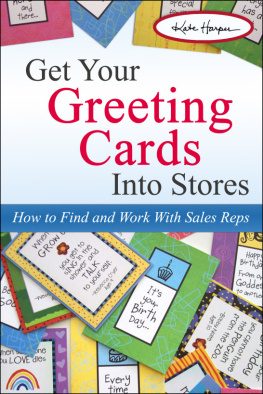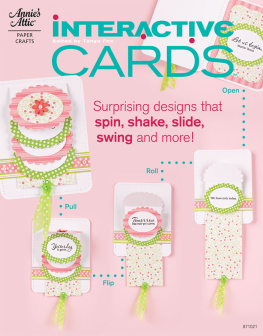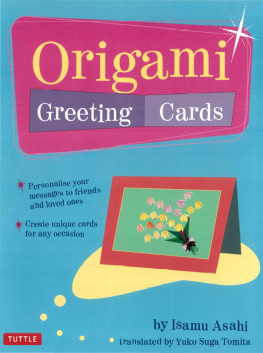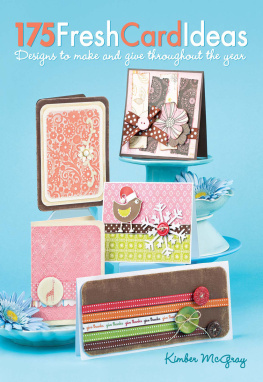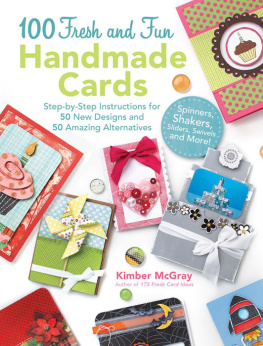GET YOUR GREETING CARDS INTOSTORES
How to Find and Work withSales Reps
By Kate Harper
Getting Your First Account
All Rights Reserved 2017Kate Harper
INTRODUCTION
For fifteen years, I published andsold my handmade greeting cards to over 2,000 accounts, includingnational chains, bookstores, grocery stores, airport gift shops,and even car washes.
From all my experience, I continue tobelieve the greeting card business is still one of the fewbusinesses a person can start at home on the kitchen table. Eventhough today more people communicate through digital media ratherthan mailing letters, I still see new indie artists entering thebusiness and succeeding, especially handmade carddesigners.
If you publish your own cards, thereare some positive trends leaning your way. Since most salesstatistics for the greeting card industry are based on figures fromlarge corporations, it is hard to know what is really going on inthe smaller, independent greeting card market.
To find out what is happening Iinterviewed several independently owned gift stores. I asked themwhat trends they see in card market and I was surprised that theyall reported an increase in sales.
When I asked them to respond tonegative news articles I'd seen about national greeting card sales,they mostly felt those statistics did not apply to them.
They reported that cards are a popularitem. They do the best with more artistic, handmade and localartist's cards and attribute it to the fact that "people want totouch paper again."
One store reported that it was commonfor a customer to come to the register with $35-$40 worth of cards,and they buy cards because they like a particular art style ortheme (and not necessarily because they need greetingcards).
All stores said they served acompletely different market than chain stores that carry greetingcards. One manager reported, "People who buy cards in our store,take time to evaluate them. People who are just running errands orneed to buy a card out of an obligation, tend to buy cards indrugstore chains."
Here are some trends theyreported:
Customers are willing tospend over $5 per card.
Younger "hipster" buyersare coming into the market.
Customers will buy cardsto keep, and frame for inspiration.
Customers often ask forhelp when selecting a card and they want to know "the story" behindthe publisher or the artist.
Cards are not alwaysmailed, but are instead given by hand, person to person.
Almost every store emphasized theircustomers buy cards for the imagery, and not for text. Trends areshifting to "thought-provoking" imagery that make the customer ask,"what is this about?" An example that was shown to me was a pictureof a moose riding a bicycle. Surprisingly, all the top sellingcards in all of the stores I interviewed did not have text onthem.
I asked store managers what artistsshould do if they want to succeed in the card business today. Hereare their suggestions:
Pay special attention toyour image. It is more important than it used to be.
Witty text isn'tnecessary. Leaving it blank or just saying "happy birthday" is goodenough.
Create more cards thatcan be bought any day of the year, and not limit them to oneoccasion.
Make cards that arecurious and unpredictable.
If you are just startingout, create Birthday, Thank You, Valentine's Day and blank cards(no words).
While my informal interviews werelimited to Northern California, some of the responses were alsoconsistent with the National Procurement Report of the greetingcard industry. This report stated that overall corporate card saleswere down, but that "...areas of growth are likely small geographiclocations, and niches in the market."
This is all good news for carddesigners in the age of technology. Rather than rely on newsreports or business analysts, the most accurate information is fromthe source: The retail store. I encourage all designers to not beshy. Ask your local independent gift retailer the same questionsthat I did.
~
When I started making my own cards, Ididn't know how to get them into retail stores, nor did Iunderstand how the greeting card business worked. I spent timelearning about the industry, sought out advice, welcomed criticismand went back to the drawing board several times to solve problemsand create new designs.
Because of my years of experience, Ioften get emails from artists who want advice. The most commonquestion they ask me is How can I get my cards into stores? Inthis book, I will answer that question and more.
Even though this book is aboutgreeting cards, the information is also applicable to all giftitems, including magnets, journals, calendars, collectibles, etc.This is because the gift industry and greeting card industry aresimilar. Stores who buy cards, often buy gifts.
My suggestions in this book are aresult of my personal experience as an artist. For every piece ofadvice I offer, another artist or publisher might do things verydifferently, which points to the fact that there is no one rightway to run a card business. This is why I like this business.There is lot of flexibility to do it things your ownway.
For example, some people believe it isessential to exhibit at industry tradeshows, which can be quiteexpensive for an independent artist. I tend to discourage this,especially for beginners, because they do not guarantee more ordersor new accounts.
I believe the best way to grow a cardbusiness is to work with independent greeting card salesrepresentatives, (also called reps). These are professionals inthe greeting card industry who sell cards to retailstores.
Why Artists Like to WorkWith Reps
Besides generating orders, there aremany benefits to working with reps. Here are just a few:
You Get Quick Access toStores.
Reps offer fast entry into themarketplace. Once a rep has a sample set of your card line, theycan start showing it to stores immediately.
Reps Can Sell More ThanArtists Can.
Reps usually have years of salesexperience and personal relationships with hundreds of stores.Therefore, a rep is able to sell many more cards than an artistcould.
Reps Know What the StoreWants.
Reps know store owners personalities,what kind of products they like, and what types of customers visiteach store. Reps build bridges between the artist, the store andthe customer.
Reps Are IndustryExperts.
Sales reps have valuable informationon buying trends and can advise an artist on how to explore newdirections.
Working With Reps HelpReduce Risk.
An artist can avoid a financial riskif they have several independent reps throughout the country. Forexample, if you put your entire card line in the hands of one storechain or distributor, and later they drop you, your business willend overnight. On the other hand, if you lose one sales rep, it isonly a temporary setback until you find a replacement.
Reps Provide CostSavings.
One of the biggest advantages ofworking with sales reps is the artist pays them a commission onwhat they wholesale price). Therefore, reps have an incentive tomore they make.
You Can AvoidRegulations.
Another benefit of working with repsis that since they federal employee regulations such workmanspayments.
Reps are Invested in theArtists Success
When a rep decides to carry a cardline, they have made a personal investment in your success. Theyhave confidence the cards will sell. It is a winwin foreveryone.
Why Stores Like to Workwith Reps
There are several reasons why storesalso like to work with reps:
Reps Offer UniqueProducts
Reps are often good at findingspecialty items, which gives smaller stores an edge over largechain stores.
Reps Save StoresTime
Stores save time by viewing many cardlines in one appointment. This is more efficient than requestingcatalogs from multiple individual artists andmanufacturers.
Next page
